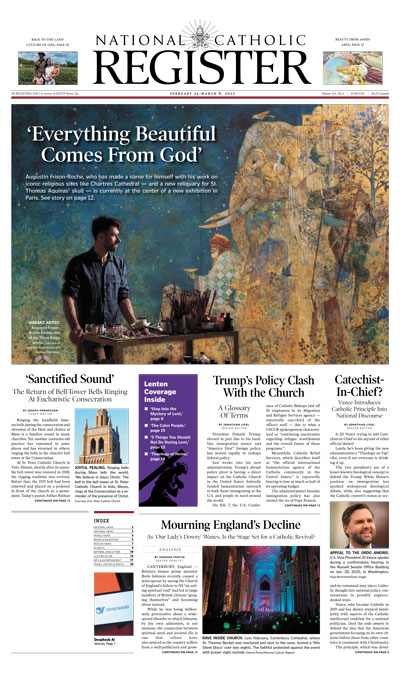Supreme Court Hears Landmark Case on Catholic Charter School in Oklahoma
COMMENTARY: With Justice Barrett recused, the Court’s remaining eight justices dive into whether faith-based schools belong in the public charter system.

The Supreme Court on Wednesday morning heard oral argument in the consolidated cases of Oklahoma Statewide Charter School Board v. Drummond and St. Isidore of Seville School v. Drummond, two cases asking whether Oklahoma can exclude a Catholic school in its charter-school program.
As I explained earlier this week for the Register, guaranteeing religious-freedom protections in school-choice initiatives is crucial for parents who consider religious schools the best fit for their children and for those religious institutions ready to meet the needs of students and families in search of alternatives to their local public school. Furthermore, consistent with recent Supreme Court precedent, recognizing St. Isidore of Seville Virtual School as a charter school in Oklahoma satisfies the demands of the U.S. Constitution.
Counsel representing the two petitioners and Oklahoma Attorney General Gentner Drummond were joined by Solicitor General D. John Sauer, who was confirmed by the Senate just days prior. While Justice Amy Coney Barrett was not present, having recused herself from participation in the case, her eight colleagues on the bench were more than sufficiently animated and engaged during the more-than-two-hour argument.
James Campbell, an attorney from Alliance Defending Freedom who is representing the Oklahoma Statewide Charter School Board, opened the discussion by dispelling any concerns that certifying a Catholic school as a charter school would violate the First Amendment’s Establishment Clause.
“St. Isidore’s was privately created by two Catholic organizations, and it is controlled by a privately selected board of directors,” Campbell said. “Under this Court’s tests, St. Isidore is neither the government nor engaged in state action.”
Responding to Justice Clarence Thomas, Campbell explained that “government creation and control” is necessary to consider an entity a state actor. Neither requirement, he said, is present here, adding that “government oversight” of the curriculum “is not sufficient to constitute state control.”
When Justice Elena Kagan asserted that charter schools in Oklahoma are government-run, Campbell pushed back: “The state is not running these schools. These schools are run by the privately selected board of directors of each school.”
Justice Sonia Sotomayor hypothetically posed a religious school that “doesn’t want to teach evolution or it doesn’t want to teach the history of slavery or doesn’t want to include having children of another faith in them.”
Campbell deftly answered that St. Isidore’s does not operate with such restrictions. Prompted by a question from Justice Samuel Alito about the problem that children may be coerced, Campbell highlighted two important considerations: No student in Oklahoma is required to go to any charter school and state law prevents entire school districts from converting into a charter school.
Up next at the podium, on behalf of St. Isidore’s, was Michael McGinley, who noted, “The Free Exercise Clause bars a state from inviting private parties to participate in an educational funding program while excluding those who exercise their faith.”
Kagan presented a hypothetical Yeshiva school in New York that insisted on an education that focused on studying the Talmud and other religious texts. She asked whether the state would be forced to cover the cost of attendance. McGinley reminded her that “no one is saying that a state is compelled to pen up these programs and to invite in the religious. What they’re saying is that what the Free Exercise Clause says is that if you do open it up, then you can’t exclude the religious because they’re religious, either because of their status or because of their use.”
In his first appearance before the Supreme Court, Solicitor General Sauer spent several minutes explaining that the demands of the Free Exercise Clause must be met in the federal charter-school program. Sauer also reinforced the private decision-making of parents who opt for a charter school, noting that “the decision whether or not to go to the religious school or the nonreligious school lies in the hands of the parents; that is genuine and independent private choice … that would not violate the Establishment Clause.”
Greg Garre, former solicitor general under President George W. Bush, represented Oklahoma Attorney General Drummond, who has been relentless in the effort to deny St. Isidore status as a charter school. Garre unconvincingly tried to distinguish the Supreme Court’s prior cases involving school-choice programs from this case.
Charter schools, said Garre, “come into existence when they are approved and become part of the state, and they’re established by the legislature.” Garre also warned that if the court ruled that Oklahoma must recognize St. Isidore as a charter school, many states would not want to fund religion and may try to rewrite their charter-school laws, thereby “limiting the options available to families.”
Chief Justice John Roberts, author of the Supreme Court’s two most recent cases dealing with school-choice initiatives, referred to the court’s recent decision involving Catholic Social Services in Philadelphia.
“What do you do with Fulton? You have a state agency that refused to deal with the religious adopted — adoption services, and we held they couldn’t engage in that discrimination.” Garre’s attempt to distinguish the foster-care placement agency wasn’t convincing to Roberts’ colleagues Justices Brett Kavanaugh or Neil Gorsuch, who both pressed Garre on the matter.
Disappointingly, Justices Sotomayor, Kagan and Ketanji Brown Jackson appear to side with excluding St. Isidore’s.
“Oklahoma has been clear that what it wants to do is use the charter system to set up a system of secular public schools,” remarked Jackson. “So, as I see it, [St. Isidore] is not being denied a benefit that everyone else gets. It’s being denied a benefit that no one else gets, which is the ability to establish a religious public school.”
Kagan added, “When I look at Oklahoma and its charter-school program, these schools look like regular public schools.”
According to Sotomayor, if the government is “paying religious teachers to teach their religion,” that would seem to violate the First Amendment’s prohibition on government establishment of religion.
It appears that principles of fairness will guide a majority of the justices on the Supreme Court. When referring to a string of recent cases where the court struck down restrictions on public funds going to schools because of their religious character and activity, for example, Kavanaugh said, “I think those are some of the most important cases we’ve had, of saying you can’t treat religious people and religious institutions and religious speech as second class in the United States.”
A Supreme Court victory for St. Isidore’s would come right in time for interested families to enroll their children for the upcoming academic school year. It could also make a Catholic education accessible to countless children, as school-choice programs are remaking education in America.















